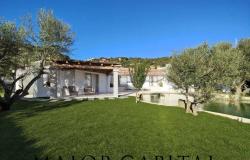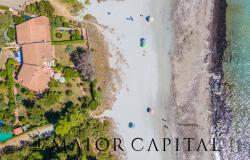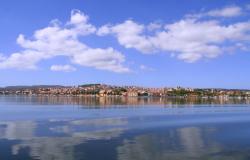The next G8 summit will take place on the La Maddalena archipelago, a cluster of tiny island off the Sardinian coast. We went to explore them and discovered turquoise waters, heavenly scented gorse, rare seagulls and a slice of Italian history
Sapphire blue wavelets crash against the sides of the ferry linking Palau, in Sardinia, to La Maddalena, the main island of a sixty strong archipelago scattered in the windy straits between Sardinia and Corsica.
As the boat gets closer to the harbour, blobs of cream, ochre and pale pink resolve into the late 19th century and early 20th century Umbertino buildings that front the waterline. The mingling scents of sea and flowering gorse fill the air.
Italian Prime Minister Silvio Berlusconi thrust La Maddalena and the nearby clutch of smaller islands into the global limelight a few months ago when he chose the archipelago as the location for the next G8 summit, which he will chair in July. I have come to take an advance look at the place and it quickly becomes evident that Berlusconi’s decision makes eminent strategic sense. Security is always the main concern at the G8 and few places are more easily defensible than this. Santo Stefano, the tiny islet where the summit will take place, is a former NATO base and is virtually uninhabited. The rest of the islands are sparsely populated and only reachable by ferry from Sardinia, which is itself an island. Shutting the ferry service and preventing private boats from entering La Maddalena’s waters on the three days of the summit should pretty much lock out outsiders—the G8 guests will be ferried in style on the enormous MSC Fantasia cruise ship—even without resorting to closing down Olbia’s Costa Smeralda airport, a measure which Berlusconi is said to be considering.
I have come to take an advance look at the place and it quickly becomes evident that Berlusconi’s decision makes eminent strategic sense. Security is always the main concern at the G8 and few places are more easily defensible than this. Santo Stefano, the tiny islet where the summit will take place, is a former NATO base and is virtually uninhabited. The rest of the islands are sparsely populated and only reachable by ferry from Sardinia, which is itself an island. Shutting the ferry service and preventing private boats from entering La Maddalena’s waters on the three days of the summit should pretty much lock out outsiders—the G8 guests will be ferried in style on the enormous MSC Fantasia cruise ship—even without resorting to closing down Olbia’s Costa Smeralda airport, a measure which Berlusconi is said to be considering.
But there is more to La Maddalena’s choice than just tight security. Beautiful is too shallow a word to give justice to the islands’ dream-like landscape. Wind and water have eroded the native granite into intricate sculptures that are at times whimsical, at times eerie. Some rocks are sinuous and round like the curves of a Rubenesque woman. Others soar high and forbidding like the spires of a Gothic church. And all tumble down into the embrace of a turquoise sea, which has embroidered the islands with narrow coves.
The waters are so crystalline that it is easy to spot fish swimming just under the surface. The odd one leaps out, catching the eye of keen Corsican seagulls—a breed that is both rarer and smaller than common gulls—which ride the wind in search of prey.
My eye, on the other hand, strays to the luxuriant vegetation that covers the countryside just above the waters. Enormous mimosa trees are laden with fluffy round flowers. Thich gorse bushes protect their sweet smelling blossoms with fearsome thorns. And here and there patches of white and pinkish purple break up this sea of green and yellow—they are the fragile flowers of rock rose shrub and the fat, lush spikes of wild topped lavender.
Hidden among this heavenly scented shrubbery, sheltered by gnarled pine, olive and holm oak trees lies a slice of little known but crucial Italian history. It is in the La Maddalena archipelago that Italian patriot and Independence hero Giuseppe Garibaldi spent the last twenty-five years of his life.
Garibaldi was exiled on the main island after the fall of the Roman Republic—an independent state founded in February 1849 and overthrown by the French in July. During his exile, he was entranced by the archipelago’s lush nature and decided to live in Caprera.
He had already made the island his home by the time he set off on the Thousand expedition in 1860, which allowed the King of Sardinia and Piedmont to conquer the Kingdom of the Two Sicilies and unify Italy. His whitewashed farmhouse, which he bought in 1855 and is now a museum, shows a surprisingly bucolic side in an action man who had been instrumental in winning independence for both Italy and Uruguay.
His whitewashed farmhouse, which he bought in 1855 and is now a museum, shows a surprisingly bucolic side in an action man who had been instrumental in winning independence for both Italy and Uruguay.
Fighting against the winds and harsh soil, this time, Garibaldi planted orange, fig and olive trees, a vineyard and an orchard, as well as setting up a thriving, technologically advanced apiary. A boat in the courtyard, which was a present from the Sardinian navy, also reveals his enduring passion for the sea—Garibaldi’s adventures started in 1822 when he signed on as a cabin boy on a Russian brig bound for Odessa.
But the seven rooms of his house, where he lived with his third wife, Francesca Armosino, and their three children, bear testament to his military spirit, with a collection of swords and guns, camp equipment and idiosyncratic clothing.
The room where he died—a later addition to the original farmhouse, built by Garibaldi’s wife to allow him to gaze at the sea in the last few years of his life—has been stuck in a time warp since the moment of his death. His eldest son, Menotti, even stopped the clock to mark the hour when his father passed away.
Although Garibaldi remains the archipelago’s most distinguished resident, the islands had already made history before he set foot on Caprera. In 1793, La Maddalena was the backdrop of a significant Piedmontese victory against the advancing French invaders when local helmsman Domenico Millelire and 700 militiamen (many of whom were inexperienced volunteers) repelled an invasion by 22 French ships led by none other than Napoleon (then a lieutenant in the French navy). Despite the overwhelming superiority of the French forces, Millelire smuggled a cannon from the islands onto the Sardinian mainland and, from there, fired a rain of balls on the French fleet at anchor on the straits. The unexpected, enormous damage led to a mutiny among the French sailors and an inglorious flight back to Corsica, with Millelire and his cannon (which he had moved onto a boat) in hot pursuit of the fleeing ships.
The unexpected, enormous damage led to a mutiny among the French sailors and an inglorious flight back to Corsica, with Millelire and his cannon (which he had moved onto a boat) in hot pursuit of the fleeing ships.
After that, the islands became a base for the Piedmontese navy, followed by the Italian and, later, NATO forces, ensuring that only dolphins, who often swim around here, could breach the waters around La Maddalena.
Berlusconi and his government clearly hope that that the archipelago will remain inviolable during the G8.












